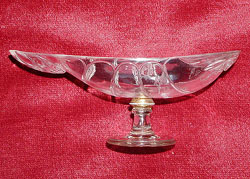06.15.2006 14:59
 9 June 2006 - 10 September 2006
9 June 2006 - 10 September 2006
The exhibition in the Blue Bedroom (Room Nr 307) features works made of rock crystal and various closely related forms of quartz: smoked quartz and amethyst. The exhibition brings together for the first time very important works which were kept in various departments of the museum. The wide time span covered, which ranges from the 5th century B.C. to the start of the 20th century, makes it possible to demonstrate in a convincing manner the merits of gem-cutters of different schools, countries and ages as well as to compare the unique methods and artistic manner of working this amazingly beautiful and warm "icy" stone.
The earliest works are by masters of the ancient world, Gillas and Pamphilus: gems, amulets, pendants. Works by master artisans of the Arab East include carved vessels, seals and weapons. Several works by oriental masters were later placed in European settings and given new uses. One such example is a vessel with central part in rock crystal made in the 10th century in Egypt, whereas the pedestal and setting date from the late 16th century and were made in Italy.
Most of the surviving crystal objects dating from the medieval period had religious use: crosses, reliquaries and candlesticks.
The modern age is represented by carved vessels: goblets, pitchers and vases which were designed by the greatest artists of the Renaissance. Renaissance works on display include splendid intaglios by the Italian gem carvers Valerio Belli and Giovanni Bernardi. The large numbers of carved stone objects coming from Italy may be explained by the proximity to the Alps, with their huge reserves of high quality rock crystal. The walls of vessels are carved so finely that a modern viewer has a hard time understanding that the objects are made of stone and not blown glass. Two great dynasties of stone carvers - the Miseroni and Saracchi - were the glory of the art of carving in hard stone in Italy and beyond, and they helped shape national artistic schools.
Collections of works from rock crystal were the pride of the largest courts of Europe. Cut crystal vessels decorated treasure rooms and "kunstkammers" and also served as diplomatic gifts. The State Hermitage has objects which once belonged to Cardinal Aldobrandini, Anna Klevskaya, Jan Sobieski, Augustus the Strong, Peter the Great, Friedrich I and Friedrich Wilhelm, among others.
During the 18th century, the traditions of artistically working rock crystal gradually faded. Crystal was used to manufacture snuff boxes and other small cases, as well as in chandeliers. Rock crystal was replaced by artistically fashioned glass, which was much cheaper and easier to shape.
However, in Russia extraction and carving of minerals only began in the 18th century and very interesting works were made by local stone-cutters. The exhibition presents gems, vessels, a series of obelisks, portable and desk-top seals produced by Russian master craftsmen. Artists of the Faberge atelier working at the end of the 19th and start of the 20th century were among the last to engage in artistic cutting of rock crystal, breathing new life into everyday articles.
Works by Chinese stone-cutters of the Qing dynasty (1644-1911) form a separate section of the exhibition. These masters invested their works with profound thought and Chinese cut stone objects are full of symbols and magical subtexts.
A scholarly illustrated catalogue of the exhibition has been issued by the State Hermitage Publishing House. The author of an introductory article and scientific editor of the catalogue as well as originator of the concept for the exhibition is O.G. Kostiuk, senior researcher and principal curator of applied art in the Department of History of Western European Art.
News source: hermitagemuseum.org
 Print this news Print this news
Culture news archive for 15 June' 2006.
Culture news archive for June' 2006.
Culture news archive for 2006 year.
|